The AMD Radeon RX 480 Preview: Polaris Makes Its Mainstream Mark
by Ryan Smith on June 29, 2016 9:00 AM ESTPower, Temperature, & Noise
Given AMD’s focus on power efficiency with Polaris – not to mention the overall benefits of the move to 14nm FinFET – there is a lot of interest in just how the RX 480 stacks up when it comes to power, temperature, and noise. So without further ado…

When it comes to idle power consumption I'm posting the results I've measured as-is, but I want to note that I have low confidence in these results for the AMD cards. Ever since the GPU testbed was updated from Windows 8.1 to Windows 10, AMD cards have idled 3-5W higher than they used to under Windows 8.1. I believe that this is an AMD driver bug – NVIDIA’s cards clearly have no problem – possibly related to the GPU tested being an Ivy Bridge-E system. In this case I don’t believe RX 480’s idle power consumption is any higher than GTX 960’s, but for the moment the testbed is unable to prove it.
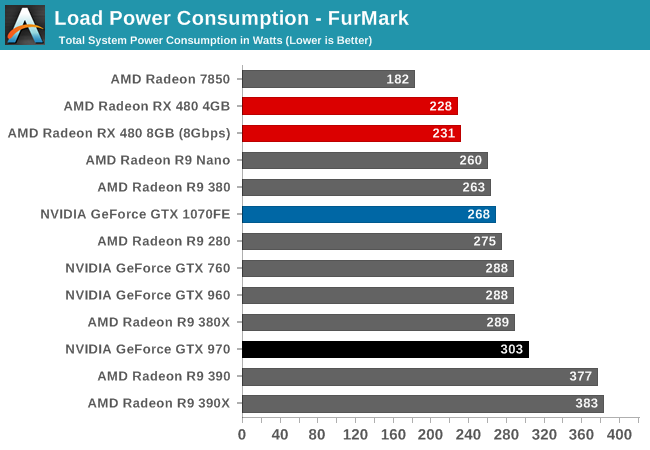
Traditionally we start with gaming load power before moving on to FurMark, but in this instance I want to flip that. As a power virus type workload, FurMark’s power requirements are greater than any game. But because it’s synthetic, it gives us a cleaner look at just GPU power consumption.
Among AMD’s cards, the RX 480 is second to only the Radeon HD 7850 in power consumption. Even then, as a GCN 1.0 card, the 7850 is one of the last AMD cards without fine-grained power states, so this isn’t a true apples-to-apples comparison. Instead a better point of reference is the GCN 1.2 based R9 Nano, which has a 175W TBP. Compared to the R9 Nano we find that the RX 480 draws about 30W less at the wall, which almost perfectly translates to the 25W difference in TBP. As a result we can see first-hand the progress AMD has made on containing power consumption with Polaris.
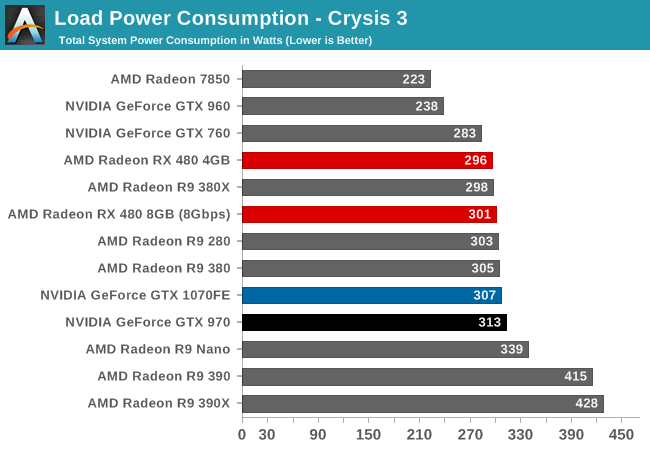
However things are a bit more mixed under Crysis 3. RX 480 is still near the top of our charts, and keeping in mind that higher performing cards draw more power on this test due to the additional CPU workload, the RX 480 compares very favorably to the rest of AMD’s lineup. System power consumption is very close to R9 280/380 for much improved performance, and against the performance-comparable R9 390, we’re looking at over 110W in savings. Hawaii was a solid chip from a performance standpoint, and Polaris 10 picks up where that left off by bringing down the power consumption to much lower levels.
The drawback for AMD here is that power consumption compared to NVIDIA still isn’t great. At the wall, RX 480 is only about 10W ahead of the performance-comparable GTX 970, a last-generation 28nm card. 1070FE further complicates matters, as its performance is well ahead of RX 480, and yet its power consumption at the wall is within several watts of AMD’s latest card. Given what we saw with FurMark I have little reason to believe that card-level power consumption is this close, but it looks like AMD is losing out elsewhere; possibly with driver-related CPU load.
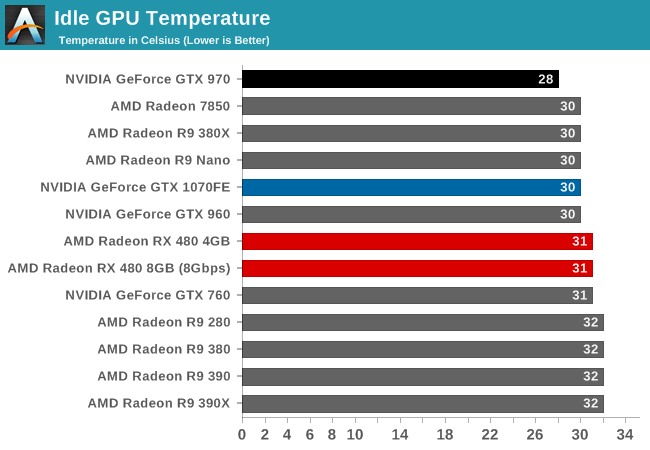
Moving on to idle GPU temperatures, there’s little to remark on. At 31C, the RX 480’s blower based design is consistent with the other cards in our lineup.
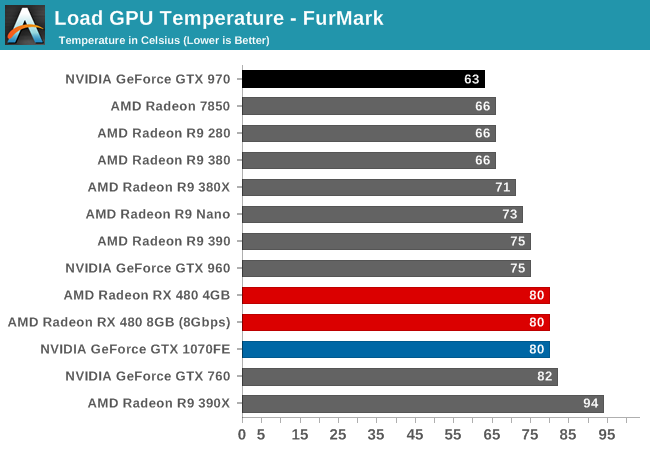
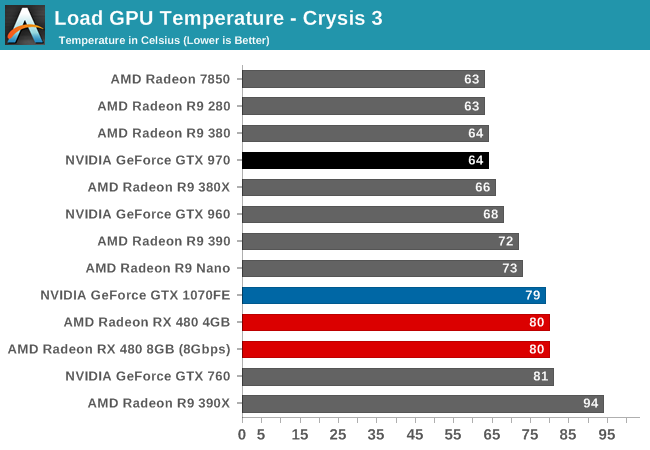
Meanwhile with load temperatures, we get to see the full impact of AMD’s new WattMan power management technology. The RX 480 has a temperature target of 80C, and it dutifully ramps up the fan to ensure it doesn’t exceed that temperature.

With idle noise levels RX 480 once again posts a good result. At 37.8dB, it’s in good company, only meaningfully trailing cards that idle silently due to their respective zero fan speed idle implementations.
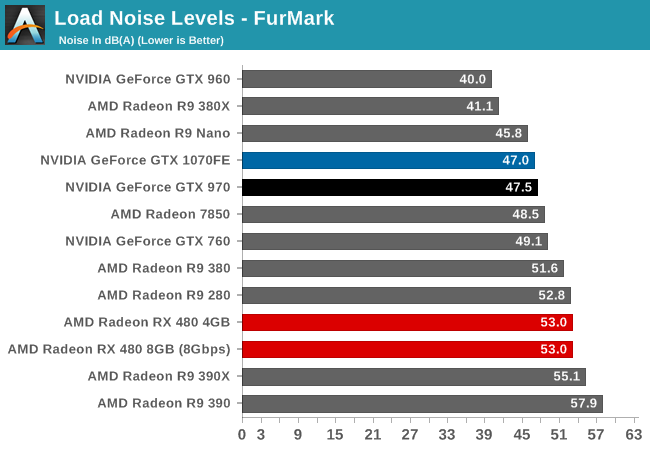
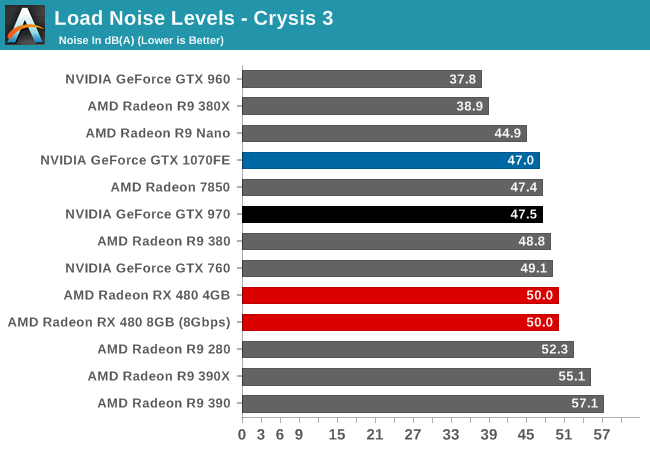
Finally, with load noise levels, RX 480 produces middling (but acceptable) results. Given that we have a mix of blowers and open air coolers here, the RX 480 performs similarly to other mainstream blower based cards. The $199 price tag means that AMD can’t implement any exotic cooling or noise reduction technologies, though strictly speaking it doesn’t need them.










449 Comments
View All Comments
FriendlyUser - Wednesday, June 29, 2016 - link
Warframe is very, very light on the GPU. I get ~100fps at 1440p with a much older card and almost everything maxed. Try Witcher 3 for a challenge at 4k.Murloc - Tuesday, July 5, 2016 - link
I can play age of empires 2 @4K on a gtx 275 get on my levelQuestor - Wednesday, June 29, 2016 - link
Bandwagon much? One picture and you are already condemning a product that hasn't had a fair chance. You hurt yourself in the long when you subscribe to bandwagon jumping by spreading fanboy-ship; opinions not based on a clear factual completeness, but rather a possible detractor that is as yet unproven across the entirety of the products. Competition serves all of us. It brings prices more under control and forces innovation.mikato - Friday, July 29, 2016 - link
"It's a terrible product. Look at the temps."I don't know about everyone else, but I don't buy my GPUs based on thermal images and point temps. Amirite?
poohbear - Wednesday, June 29, 2016 - link
How is it a bit disappointing??? do you really think most of us are running GTX970s?? The vast majority of people have gtx950 class cards, and this would be a nice step up considering the price.sharath.naik - Wednesday, June 29, 2016 - link
Its disappointing because, 970 can overclock 10-15% sometimes more. You need to look at the thermals to understand that these are like already overclocked from the factory and cannot do more.smartthanyou - Wednesday, June 29, 2016 - link
In no situation will a 10-15% overclock ever produce a performance difference that an end user would notice. In a benchmark application? Sure, numbers will increase but frames in a game will not increase to a point to make a difference.Overclocking 10-15% in almost all cases is pointless.
FriendlyUser - Wednesday, June 29, 2016 - link
All these are reference and have zero electrical margin for overclock. Reviews have shown that the board uses all juice it can and is almost constantly at the limit (or over) of the PCIe slot power delivery! You will only be able to judge overclock in cards with more complicated designs. The chip itself is probably quite variable, being the first of the 14nm AMD generation. Some will overclock well, others wont.wumpus - Wednesday, June 29, 2016 - link
Last I heard, 970 was at the top of the steam surveys (I won't enable whatever kludge they wanted to find out). It isn't a bad goal, but my confidence in AMD shipping it to newegg faster than nvidia can ship an as of yet hypothetical 1060 isn't all that great. Assuming they do, it doesn't really mean they have a long window of "the card to buy at ~$200".A bigger worry is how many of those 970s are going to be hitting the market. Until AMD can claw back some marketshare, there could easily be a used 970 for every new 480 buyer out there. And this is coming from someone who had been assuming that I would get a 390 (or two) and DYI some watercooling for an ideal VR rig (before prices skyrocketed. I'm guessing lose the watercooling and go with nvidia once both VR and nvidia 14nm prices come back to Earth). This card isn't helping AMD all that much.
lunarmit - Wednesday, June 29, 2016 - link
It is, but it's just one card. Add in 1% for the 980, and 1% for the 980 ti and you have ~90% of the cards are powered below that once you factor in the AMD comparables.